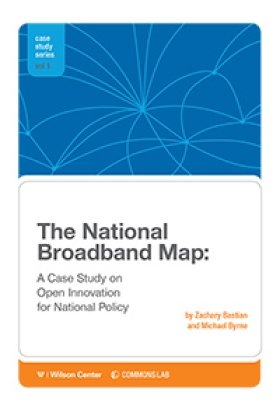The National Broadband Map: A Case Study on Open Innovation for National Policy



Authors: Zachary Bastian, Commons Lab of the Wilson Center and Michael Byrne, FCC.
Study Director: Lea Shanley. Editors: Lea Shanley and Aaron Lovell. On behalf of the Commons Lab within Science and Technology Innovation Program, Woodrow Wilson Center, with the support of the Alfred P. Sloan Foundation.
The National Broadband Map, designed to provide consumers nationwide reliable information on broadband internet connections, was built incorporating emerging technology. It protects consumers, holds the government and private sector accountable, and engages the public across the United States. In a time of budgetary constraint, the Map made a series of remarkable policy innovations that allowed the project to be completed in minimal time and at a reduced cost.
The public was engaged before, during, and after the project. Citizens generated speed testing data. They provided comments and feedback on improving internet connectivity. They used a National Broadband Map crowdsource utility to let the FCC know whether the information they posted was accurate. The data collected is open, freely available to anyone. The application itself was built using open-source software unchained by licensing fees, enhancing its flexibility and accessibility. The development process broke from traditional government procurement, and programmers regularly communicated with users to better understand the needs of the project: this avoided cost overruns and unused features.
The incorporation of geographic information systems allows users to learn of broadband internet options in their area, and policymakers to identify geographic gaps in service needing support. This combination of techniques created a flexible resource that has already guided appropriations through the Connect America Fund. It continues to be applied to other communications challenges such as mobile broadband connectivity. The National Broadband Map demonstrates there is room for agencies to innovate and promotes a national conversation on how to improve government outcomes in the 21st century.
The National Broadband Map is a vital example of the benefits available to all when government prioritizes transparency, allows itself to be guided by the public, and directs policy based on robust and reliable data.
Click here for a video of this event.



The Science and Technology Innovation Program (STIP) serves as the bridge between technologists, policymakers, industry, and global stakeholders. Read more


